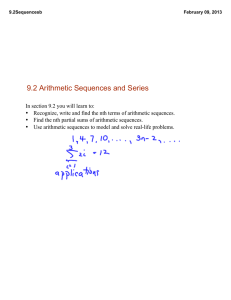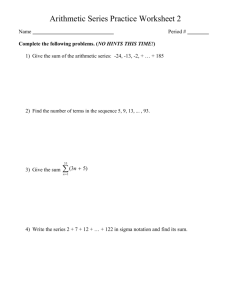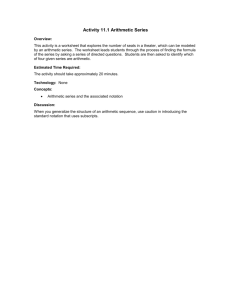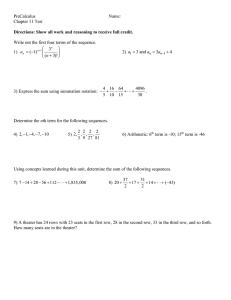9.2 Arithmetic Sequences and Series
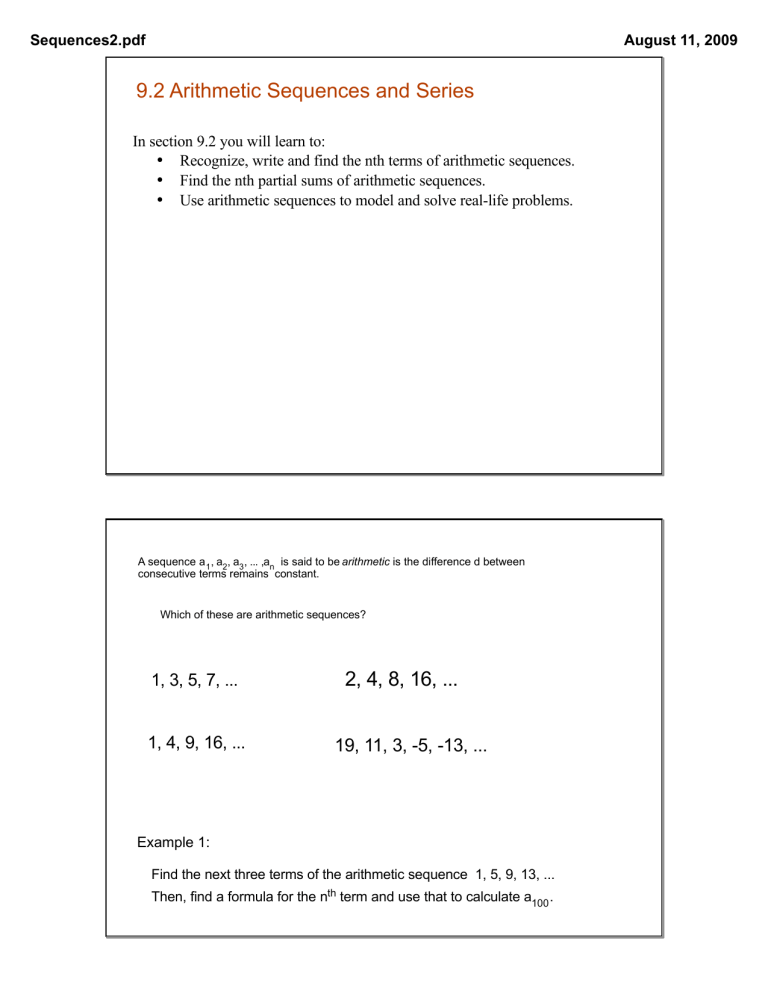
Sequences2.pdf
9.2 Arithmetic Sequences and Series
In section 9.2 you will learn to:
• Recognize, write and find the nth terms of arithmetic sequences.
• Find the nth partial sums of arithmetic sequences.
• Use arithmetic sequences to model and solve real-life problems.
August 11, 2009
A sequence a
1
, a
2
, a
3
, ... ,a n
is said to be arithmetic is the difference d between consecutive terms remains constant.
Which of these are arithmetic sequences?
1, 3, 5, 7, ...
1, 4, 9, 16, ...
2, 4, 8, 16, ...
19, 11, 3, -5, -13, ...
Example 1:
Find the next three terms of the arithmetic sequence 1, 5, 9, 13, ...
Then, find a formula for the n th term and use that to calculate a
100
.
Sequences2.pdf
How would you describe the graph of an arithmetic sequence?
```````````````````````````````````````````````
1 2 3
Example 2:
Suppose the 4 th term of an arithmetic sequence is 20 and the 13 th term is 65.
What are the first six terms of the sequence?
Example 3:
A local theatre has a large auditorium with 22 rows of seats. There are 18 seats on Row
1 and each row after Row 1 has two more seats than the previous row. How many seats are in Row 22?
August 11, 2009
Sequences2.pdf
A finite arithmetic series is the sum S sequence.
n
of the first n terms of a finite arithmetic
Sn = a
1
+ (a
1
+d) + (a
1
+ 2d) + (a
1
+ 3d) + ... + (a
1
+ (n-1)d)
S n
can be found by computing S n n
2
(a + a )
August 11, 2009
An alternate formula for S n
is S n
= n
2
[2a
1
+ (n-1)d]
Example 4:
Use the summation notation to write these series and find the sums using either of the formulas: or
S n
= n
2
(a
1
+ a n
)
S n
= n
2
[2a
1
+ (n-1)d] a) 1 + 3 + 5 + 7 + 9 + 11 + 13 + 15 + 17: b)
30
∑
j=1
(9+3j)
Sequences2.pdf
Example 5:
In the theatre we described previously, there were 22 rows of seating. There were 18 seats on Row 1 and each subsequent row had two more seats than the previous row.
What is the seating capacity of the auditorium?
August 11, 2009
Example 6:
In the last lesson, you decided to save for your trip to Europe. You opened a savings account with $1.00 and on each subsequent day, you deposited a dollar more than on the previous day.
How much have you contributed by the end of one year?



